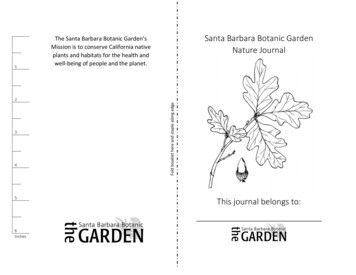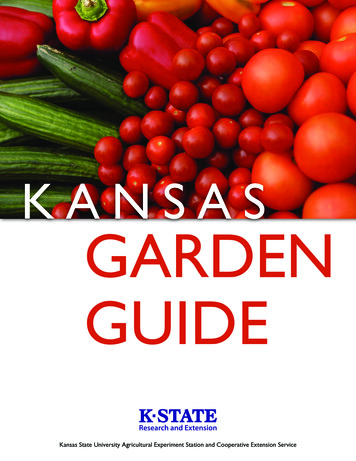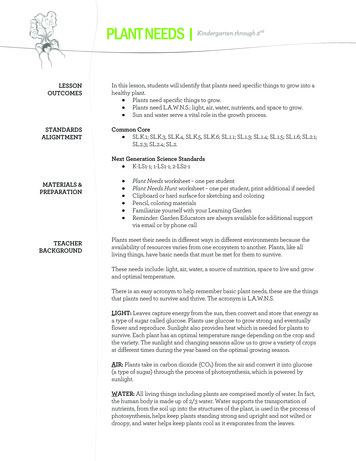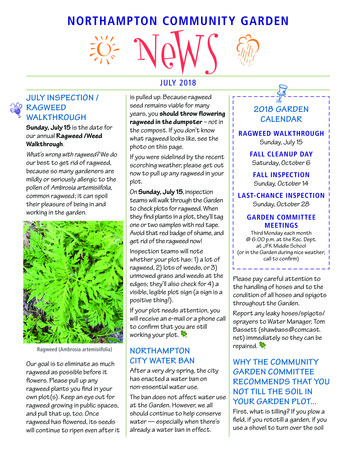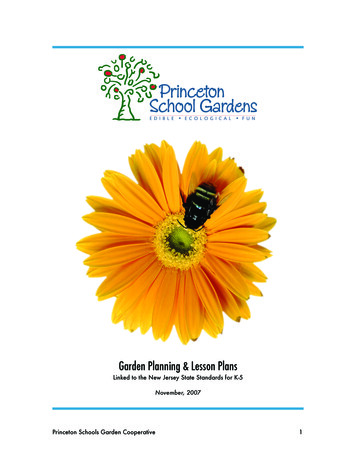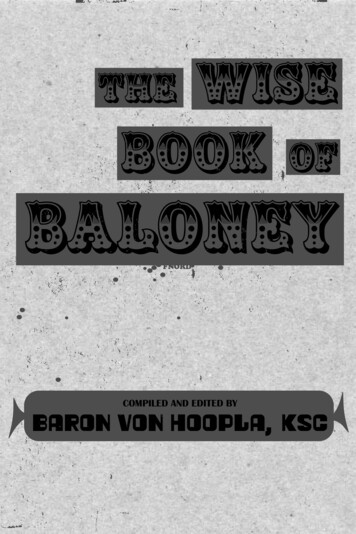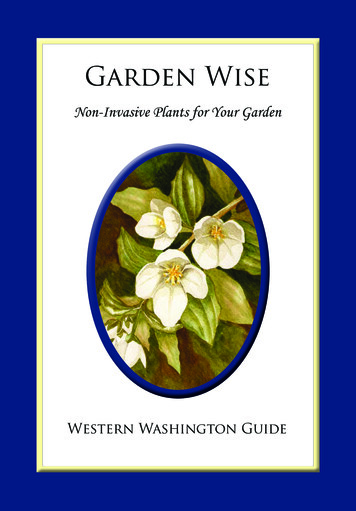
Transcription
Garden WiseNon-Invasive Plants for Your GardenWestern Washington Guide
Voluntary codes of conductFor the gardening public (annotated):In an effort to reduce the spread of invasive plants used forhorticultural purposes, experts have created the “VoluntaryCodes of Conduct,” a series of steps that nursery professionals,landscape architects, gardeners, and others can take to help curbthe spread of invasive horticultural plants. Ask for only non-invasive species when you acquire plants.Plant only environmentally safe species in your gardens.Work towards and promote new landscape design that isfriendly to regional ecosystems. Seek information on which species are invasive in your area.Sources could include botanical gardens, horticulturists,conservationists, and government agencies. Remove invasivespecies from your land and replace them with non-invasivespecies suited to your site and needs. Do not trade plants with other gardeners if you know theyare species with invasive characteristics. Request that botanical gardens and nurseries promote,display, and sell only non-invasive species. Help educate your community and other gardeners in yourarea through personal contact and in such settings as gardenclubs and other civic groups.For the full Gardening Codes of Conduct, or to learn aboutthe Codes of Conduct for Government, Nursery Professionals,Landscape Architects, and Botanic Gardens and Arboreta, pleasego to the Center for Plant Conservation’s website des2012.aspGarden Wise is dedicated toAnn Lennartz
Garden WiseNon-Invasive Plants for Your GardenWhile most exotic plants are not problematic, a few have becomeinvasive in Washington State. When these plants spread towild areas, they cause serious problems. For example invasiveknotweeds, butterfly bush, and yellow flag iris are changing ourstreamsides and riverbanks; spurge laurel and Atlantic ivy arealtering our forests.This booklet represents the collaboration of nonprofitconservation groups, state and country government, and thenursery industry. We believe that preventing introduction is themost efficient way to reduce the spread and impact of invasivespecies. Whether you are looking for new and exciting plants toadd to your garden, or you are looking to replace invasive plantsin your yard, we hope this book will be a valuable resource.Working together, we can ensure that future generations enjoypristine wild areas in Washington State.Please note that this booklet is a product of an ongoing project.Visit www.nwcb.wa.gov for updates and to learn about otherproblematic plants and their alternatives. You can also learnmore from your local nursery, WSU Master Gardeners, and atwww.GreatPlantPicks.org.Full SunRegular WaterWell-DrainedSoilPart SunMedium WaterHeavy SoilFull ShadeLow duousGreat PlantPick
HerbaceousCommon Fennel - Foeniculum vulgareeivsvanINon-bulbing varieties ofRecommended Alternative 2 this herb are prized for theirtall, feathery, aromatic, andoften colorful foliage. However, thisperennial colonizes grasslands anddisturbed areas, including roadsidesand abandoned lots, where densestands can crowd out native flora.Fennel escapees are a seriousproblem in California, particularlyin natural, open lands and alongthe coast. Fennel invasions arebecoming a common sight inwestern Washington and may posean additional threat to our state’svanishing grasslands.Class B Washington State Noxious WeedFlorence Fennel, Finocchio, Bulbing FennelFoeniculum vulgare var. azoricumThis annual plant is most likecommon fennel, with the samefeathery foliage and is ideal forculinary uses. The flavor of foliage and seeds isvery similar to common fennel,and the swollen stem base isa crispy, flavorful vegetable usedin many cuisines. The foliage is green and has afeathery texture like commonfennel, but the plant is smaller instature (2-3 feet, not 4-6 feet). Like common fennel, Florencefennel likes full sun and welldrained soils. The yellow flowers attractbutterflies, and butterfly larvaefeed on the foliage. USDA zones 4-9
Recommended AlternativeDillAnethum graveolensThe foliage of this plant is alsofeathery and reaches 3-4 feet. With a wonderful featheryfoliage, dill offers a fennel-likehazy texture, although the plantis slightly smaller in stature. Dill is easy to grow in sunny, welldrained sites. This annual will self-sow in yourgarden, so remove spent flowerheads before seeds scatter. Flat yellow flowers appearabout the same time as thoseof fennel, attracting butterflies,and butterfly larvae feed on thefoliage. USDA zones 3-7Recommended AlternativeCosmosCosmos bipinnatusCosmos foliage is ferny likecommon fennel, but its daisy-likeflowers differ. This annual has a long bloomtime, from summer into autumn. It can add pink, purple or whitecolor to the garden. The profuse, 3-inch daisy-likeflowers, create a different effect inthe garden than fennel. Easy to grow and care for, cosmoscan be deadheaded to prolongflowering. Cosmos prefers well-drainedsoils and needs sunny sites, likecommon fennel. USDA zones 3-10Image courtesy of Trois HelvyMore choices: Amelanchier alnifolia, Cornus stolonifera (Syn. Cornus sericea),Holodiscus discolor, Hydrangea macrophylla, Physocarpus capitatus, Woodwardiafimbriata, and Calamagrostis x acutiflora ‘Karl Foerster’ all of which areWashington natives except for Hydrangea and Calamagrostis. 3 Courtesy of Deborah Jordan, Solas Gardens
HerbaceousPoliceman’s Helmet - Impatiens glanduliferaeivsvanIPoliceman’s helmet has pretty pink-to-purple flowers andRecommended Alternative 4 is unusually tall for an annual plant, reaching amaximum height of 10 feet. A garden escapee, thisprolific, self-seeding plant has heavily colonizedlowland riparianareas, includingforests, streambanks, androadsidethickets,where it dominates nativeplant communities. Althoughconsidered a serious problem inGreat Britain, and on the WSDAquarantine list, it is still oftenillegally exchanged amongstImage courtesy of King County NWCBgarden groups in Washington.Class B Washington State Noxious WeedMilky BellflowerCampanula lactiflora ‘Loddon Anna’An upright long-bloomingperennial for a well-drained, sunnyto partly shady site. This easy-to-grow perennial willlast in your garden to add colorand texture over many years. The upright habit, reaching up to4 to 5 feet, adds similar textureand height to the garden. Beautiful light lilac-pink starshaped flowers in panicles aresimilar in color, but not form, topoliceman’s helmet. Blooms mid-summer, trim backfading flowers to encourge rebloom later in the season. USDA zones 5-8Image courtesy of Ann Chapman
Recommended AlternativeDelphinium, LarkspurDelphinium parishii ‘Sky blue’and Delphinium x elatumAn upright, taller herbaceousperennial for a sunny site. The flower color ranges fromwhite to deep lavenders and blues. Some cultivars reach heightssimilar to policeman’s helmet. Spurred flowers on long spikesattract butterflies. This deciduous perennial growsback stronger each year. Checkwith your local nursery fordisease-resistant cultivars. USDA zones 4-7Recommended AlternativeCardinal FlowerLobelia cardinalis & cultivarsAn upright herbaceous perennialfor a moist, sunny to partly shadysite. Cardinal flower grows in similarconditions as policeman’s helmet:moist soils and part shade. Showy flower spikes can reachheights of 3 feet, shorter thanpoliceman’s helmet. Blooms are generally brightcrimson, though color can rangefrom orange-red to fuschia topurple in some cultivars. A popular choice for attractinghummingbirds. USDA zones 3-10Image courtesy of Erv Evans,North Carolina State UniversityMore choices: Cleome species, flowering tobacco (Nicotiana mutabilis), Japanese primrose(Primula japonica), Thalictrum delavayi ‘Hewitt’s Double’, and natives: western meadow-rue(Thalictrum occidentale), bleeding heart (Dicentra formosa), western blue flax (Linum perenne),monkeyflowers (Mimulus guttatus and M. lewisii), and inside-out flower (Vancouveria hexandra). 5 Image courtesy of Monrovia Nursery
HerbaceousevsiavInTall or Purple Verbena - Verbena bonariensisTall verbena has been a popular addition to gardenborders for its lavender, tubular flower clusters borneatop elevated flower stalks. Although attractive inthe garden, thisvigorously selfseeding perennial israpidly spreading intofields and open areasaround the world,including the state ofOregon, and is on its way to beinga problem in western Washington.The prickly hairs on the stem makethis weed difficult to hand pull.Identify it early and nip it in thebud!Recommended Alternative 6 Image courtesy of John Randall,The Nature ConservancyWashington State Monitor SpeciesRussian SagePerovskia atriplicifoliaThis sage is a long-bloomingperennial for a sunny, dry site. Twelve-inch spires of smalltubular purple flowers add a tallsplash of color in late summer. Like purple verbena, Russian sageis a drought-tolerant plant onceestablished that does well in poorsoils. Similar in height to tall verbena,Russian sage adds a strongvertical element to the gardenwith its silvery stems and foliage. USDA zones 5-9Image courtesy of Alice B. Russell,North Carolina State University
Recommended AlternativeFrikart’s AsterAster frikartii ‘Mönch’This prolific bloomer grows in amounded form in full sun. The long flowering period (JulyOctober) offers lavender-blueflowers throughout the season. A more densely branched habitthan tall verbena, Frikart’s astergrows 1.5 to 3 feet tall, prefersfull sun but can grow in partshade. Provides color in the landscapewhen other plants are dying backin autumn. Its 2.5 inch flowers attractpollinators such as butterflies. USDA zones 5-8Recommended AlternativePincushion FlowerScabiosa caucasica ‘Ultra Violet’An ever-blooming perennial for awell-drained, sunny site. This cultivar’s bright violetpincushion-shaped flowers areperched on thin stems to 2 feettall Pincushion flower is not onlygreat for cutting, but it alsoattracts butterflies in the garden. ‘Ultra Violet’ is a new cultivarwith greater disease resistancethan past offerings. USDA zones 4-9Image courtesy of Kennedy HarrisMore choices: Homestead purple verbena (Verbena ‘Homestead Purple’), andPenstemon or beardtongue (Penstemon) species, many of which are Washingtonnatives. 7 Image courtesy of Bellevue Botanical GardenSociety, Great Plant Picks
HerbaceousKnotweeds - Polygonum specieseivsGiant, Bohemian, Himalayan, & JapanesevanIFeathery white flower heads, largeRecommended Alternative 8 foliage, and tall, bamboo-like stems oncemade this group of knotweeds popular asgarden ornamentals. Native to Asia, knotweedshave become a serious problem worldwideand areincreasinglyprevalent inWashington. They rapidly invaderiparian zones: blocking sunlight,disturbing nutrient cycling, andfacilitating stream bank erosion.These knotweeds are a seriousproblem along Washington Statewaterways where they degradehabitat for wildlife and fish speciesincluding salmon.Image courtesy of Whatcom County NWCBClass B Washington state noxious weed’sGoats BeardAruncus dioicusThis robust perennial nativeprovides height to your garden. Like knotweed, goat’s beardthrives in moist soil. It produces a panicle of creamcolored flowers similar toknotweeds, though foliagetexture is finer. Blooms in June and July, a littleearlier than knotweeds. Goat’s beard grows up to 6 feettall. USDA zones 3-7Image courtesy of Erv Evans,North Carolina State University
Recommended AlternativeFothergillaFothergilla majorThis is a deciduous shrub withgorgeous fall foliage. Small, fragrant white flowersbloom in spring, unlike the laterblooming knotweeds. Green foliage in summer turns tospectacular fall color, as opposedto less colorful knotweeds. Like knotweeds, fothergilla sportslarge leaves up to 5 inches long. Shrub grows up to 9 feet tall. Cultivar ‘Mt. Airy’ grows 5 to 6feet tall and is a Great Plant Pick. Also known as witch-alder, thisshrub prefers moist, well-drainedsoils. USDA zones 4-8Recommended AlternativeRobusta Clumping BambooFargesia robustaThis is a true clumping bamboowith an upright form. It grows to 15-20 feet, taller thanknotweeds. Unlike knotweeds and runningbamboo varieties, clumpingbamboo varieties steadilyincreases in diameter. The stems provide the bambooeffect that gardeners prize inknotweeds. Unlike the knotweeds, Fargesiarobusta keeps its narrow, shinyleaves in the winter for yearround interest. It takes morning sun andafternoon shade. USDA zones 7-9Courtesy of Noah Bell, bamboogarden.comMore choices: Western serviceberry (Amelanchier alnifolia), ocean-spray (Holodiscus discolor),Pacific ninebark (Physocarpus capitatus), giant chain fern (Woodwardia fimbriata), redosier dogwood (Cornus stolonifera), all of which are Washington natives, as well as bigleafhydrangea (Hydrangea macrophylla) and giant fleeceflower (Persicaria polymorpha). 9 Image courtesy of Victor Carrano
GroundcoverYellow Archangel - Lamiastrum galeobdoloneivsvaStriking variegated leavesnIand the ability to thriveRecommended Alternative 10 in shady areas makes yellowarchangel a popular ornamentalplant for groundcoverand hanging baskets.Unfortunately,this trailing planteasily establisheswild populations, inmany cases as theresult of improperdisposal of gardencuttings or hangingbaskets. Yellow archangel forms dense,homogenous mats in forests and parksand is a serious problem in BritishColumbia and western Washington.Class B Washington State Noxious WeedWintercreeperEuonymus fortunei ‘SilverQueen’& ‘Emerald Gaiety’This is a low-growing evergreenplant with attractive foliage. The variegated leaves ofwintercreeper provide contrast inthe low light preferred by yellowarchangel. Wintercreeper will tolerate fullsun as well as the shade thatyellow archangel prefers. USDA zones 4-8Image courtesy of Monrovia Nursery
Recommended AlternativeHeucheras & HeucherellasHeuchera & Heucherella speciesLow-growing perennials, somenative to the Northwest. These plants produce small, airyflowers above ornamental leavesin a variety of colors and patterns,rivaling the foliage of yellowarchangel. Heucheras and heucherellastolerate sun to light shade. Their delicate flowers are alsoattractive to hummingbirds. USDA zones 4-9Recommended AlternativeWild Ginger 11 Top Heuchera Image : Victor CarranoBottom Heuchera Image: Terra Nova NurseriesAsarum caudatumEvergreen groundcover growing inpart to full shade. Beautiful deep green, heartshaped leaves smell of lemonginger when crushed. Unique purple-brown flowers thatmay be covered by leaves, unlikethe insignificant flowers of yellowarchangel. Grows in a variety of gardenconditions and is drought tolerantonce established. Grows by rhizomes and slowlyforms expanding mats. USDA zones 7-9Image courtesy of Richie Steffen, Great Plant PicksMore choices: Bleeding heart (Dicentra formosa), wild lily-of-the-valley (Maianthemumdilatatum), three-leaf foamflower (Tiarella trifoliata), all of which are Washington natives, aswell as Japanese Spurge (Pachysandra terminalis), barrenwort (Epimedium) species, sweetbox(Sarcococca hookeriana var. humilis), and minature London pride (Saxifraga ‘Primuloides’).
GroundcoverOld Man’s Beard & Silverlace VineeivsClematis vitalba & Polygonum albertiivanIClimbing vines suchRecommended Alternative 12 as old man’s beard andsilverlace vine are commonlyused on arbors and trellises. Yetthese vines can establish in forestsand along riverbanks where theycan smother shrubs and trees andform dense mats in the understory,displacing native flora. Bothvines produce thousands of tinyseeds, which are spread by windor carried on the bodies of birds.Silverlace vine can also regeneratefrom garden cuttings tossed aside,making escape from cultivationeasy.Images courtesy of King County NWCB.Class C Washington State Noxious Weed & Monitor SpeciesSweet Autumn ClematisClematis paniculata,synonym C. dioscoreifoliaThis clematis is a vigorous andfragrant climber. This clematis has fragrant creamywhite flowers. Like the invasive vines, this is arobust climber. It takes full sun to partial shade. Like silver lace vine and old man’sbeard, Sweet Autumn clematisblooms from summer to fall. This climber grows up to 20 feettall. USDA zones 5-9Image courtesy of Monrovia Nursery
Recommended AlternativeItalian ClematisClematis viticella & cultivarsThis species includes a variety ofcolorful cultivars. There are various flower colors tochoose from, whereas the invasivevines offer only white. Growing only 15 feet tall, it doesnot overburden trees like theinvasive vines. This clematis prefers full sun. Like silverlace vine and old man’sbeard, this plant is not particularabout soil type. Zones 5-9Recommended AlternativeOrange HoneysuckleLonicera ciliosaOrange honeysuckle is a colorfulnorthwest native that butterfliesand birds love too. The flowers are a brilliant orangeinstead of white. It grows up to 30 feet tall, like oldman’s beard. This native takes full sun topartial shade. Blooms occur from May to July,earlier than either of the invasivevines. Birds and butterflies are attractedto its edible berries and nectarflowers. Zones 6-9Image courtesy of Ben LeglerMore choices: Kiwi vine (Actinidia kolomikta), chocolate vine (Akebia quinata), Japanesehydrangea vine (Schizophragma hydrangeoides), climbing hydrangea (Hydrangeaanomala subsp. petiolaris), and silvervein creeper (Parthenocissus henryana). 13 Image courtesy of Pat Breen, Oregon State Univ.
GroundcoverevsiavInAtlantic & Invasive English Ivy CultivarsHedera hibernica & Hedera helix ‘Baltica’,‘California’, ‘Pittsburgh’, & ‘Star’Recommended Alternative 14 While over 400 cultivars ofivy are used for landscaping,only a few are considered invasive.When allowed to climb and mature,invasive ivies produce seed-filledberries which are spread by birds.A serious problem in westernWashington, these cultivars spreadinto forests where the vines blocksunlight, smother trees, andencourage rot. Dense mats of ivyblanket the forest understory,displace native flora, outcompeteforest seedlings, and harbor pestssuch as rats.Class C Washington State noxious weedCrinkle-Leaf CreeperRubus pentalobussynonym Rubus calycinoidesForms a great, durable carpetof rough leaves, dark green insummer and tinged reddish inwinter. This creeper is a goodgroundcover for slopes and willgrow to cover larger spaces. It is drought tolerant like ivy,once established. Crinkle-leaf creeper is anattractive evergreen, finer intexture than ivy—with leaves thesize of strawberry leaves. It grows well in sun and partialshade and remains healthy withlittle care. USDA zones 6-9Image courtesy of Pat Breen, Oregon State Univ.
Recommended AlternativeKinnikinnickArctostaphylos uva-ursiA great native plant for carpetingthe ground, Kinnikinnick helpssustain wildlife. Its evergreen foliage and mat-likespreading habit give an emeraldlook year-round. Like ivy, kinnikinnick is adaptedto well-drained sandy soils andsun. Though drought tolerant onceestablished, unlike ivy, it doesnot tolerate shade. Unlike ivy, kinnikinnick flowersare ornamental. Whitish-pinkbells appear in summer, followedby red berries. USDA zones 5-10Recommended AlternativeClimbing Hydrangea 15 Image courtesy of Ben LeglerHydrangea anomala subsp.petiolarisA good vine for climbing trees orwalls or fences: holds on like ivy.Medium green, heart-shaped leavesare beautiful, but different intexture and scale. Large-leaved deciduous foliagewill cover like ivy in summer, andcinnamon-red shaggy bark offerswinter texture. Unlike ivy, it has beautiful laceyhydrangea-like blooms of creamwhite in June which are good fordried arrangements. Plant is relatively disease free andeasy to care for. USDA zones 4-8Image courtesy of Monrovia NurseryMore choices: silvervein creeper (Parthenocissus henryana), minature London pride (Saxifraga‘Primuloides’), bearberry (Cotoneaster dammeri), wintercreeper (Euonymus fortunei), boxleafhoneysuckle (Lonicera pileata), sweetbox (Sarcococca hookeriana var. humilis), Boston ivy (Parthenocissustricuspidata) and natives beach strawberry (Fragaria chiloensis) and evergreen violet (Viola sempervirens).
w e t l a n d a n d a q u at i cYellow Flag Iris - Iris pseudacoruseivsvaWith its showy yellownIflowers and dense, lance-Recommended Alternative 16 shaped leaves, yellow flagiris has been a popular additionto ornamental ponds and watergardens. However, this emergentwetland plant quickly spreadsthrough underground rhizomes andrhizome fragments. It naturalizesalong streams, canals, andshorelines in Washington. Yellowflag iris can completely out competenative wetland plants along theshoreline, and its dense, root-likemat collects sediment and severelyreduces water flow, affecting plants,fish, and other animals.Class C Washington State Noxious WeedJapanese IrisIris ensata cultivars including ‘Variegata’These are beautiful irises for pondedges and bogs. They are ideal for wet boggy areasand edge-of-pond plantings, easyto grow. Elegant large flowers of white,purple, and violet blue form inlate spring and early summer, alittle after yellow flag iris. Foliage can reach 16 inches, thescale of the plant is smaller thanyellow flag iris. The foliage of the cultivar‘Variegata’ offers a creamy whiteand green foliar accent to pondplantings. USDA zones 5-8Image courtesy of Laura Burton
Recommended AlternativeLaevigata IrisIris laevigata & cultivarsA true water-loving iris, beautiful inand out of flower. An ideal replacement for yellowflag iris in pond plantings,laevigata iris grows well in 6inches of water. It is also good forwet boggy areas, and it’s easy togrow. Flowers are large white, purple,lavender, and pink. Yellowblooming cultivars are rare. Blooms later than yellow flag iris. Foliage can reach 18 inches, sothe scale of the plant is smallerthan yellow flag iris. USDA zones 2-9Recommended AlternativeSiberian IrisIris sibirica & hybrids such as ‘Butter & Sugan’, ‘Sunfisher’(both yellow blooming)A very versatile, easy-to-grow iris:the one to choose, other than abearded iris, if you want yellowflowers.‘Butter & Sugan’, ‘Sunfisher’ Good for mixed borders withnormal water needs; also suitablefor damp sites, but not forstanding water. Flower colors range from white topurple to blue-purple to yellow. With foliage usually 2 feet or less,and taller flowers, the plant issmaller than yellow flag iris. Blooms May-June, but its lovelyfoliage makes this iris beautiful inand out of bloom. USDA zones 4-9Image courtesy of Todd BolandMore choices: Arctic iris (Iris setosa), blue flag irises (Iris versicolor and Iris virginica),bearded iris (Iris x germanica), and native species Rocky Mountain iris (I. missouriensis),western skunk cabbage (Lysichiton americanum), and golden-eyed grass (Sisyrinchiumcalifornicum). 17 Pat Woodward, Pacific Rim Native Plant Nursery
W e t l a n d a n d a q u at i cFragrant Water Lily - Nymphaea odorataeivsvanIAlthough native to the eastern half of the United States,Recommended Alternative 18 fragrant waterlily has been deliberately introduced into pondsand water gardens in the Pacific Northwest because of its largeand beautiful,sweet-smellingwhite flowers.However,this floatingleaved plantcan quicklydominate thewater, denying submerged aquaticvegetation light and oxygen,stagnating water flow, degradinghabitat for fish and invertebrates,and restricting wildlife andImage courtesy of Stevens County NWCBhuman access to water bodies.Class C Washington State Noxious WeedFragrant Waterlily cultivarsNymphaea ‘Lucianna’,N. ‘Pink Beauty’, N. ‘Hermine’These fragrant waterlilies are idealfor contained water gardens. Less aggressive cultivars ofNymphaea, such as the Marliaccultivars, come in a wide range ofboth bold and subtle colors. These water garden plants shouldnot be placed in natural ponds,lakes, streams, or rivers wherespread may be a danger ora problem. USDA zones 3-11Courtesy of Erv Evans,North Carolina State University
Recommended AlternativeWater ShieldBrasenia schreberiA native aquatic plant with smallfloating leaves. Floating oval leaves are dark greenon top and purple underneath. Water shield grows in water 2-6feet deep. Found in lakes around westernWashington, water shield is safeto use in natural water bodies toreplace fragrant waterlilies. The small, dark purple flowersthat appear in late summer areattractive but unlike fragrantwater lilies’ showy blooms. Fish and other wildlife use thisplant for valuable food and shelter.Recommended AlternativeSpatterdockNuphar polysepalaA large native aquatic plant foundin a range of water depths. Floating leaves on stiff stemssometimes lift above the waterduring low water levels. The showy yellow flower isdissimilar to fragrant waterlily’slotus-like bloom, but no less eyecatching. This native plant is foundin ponds and lakes aroundWashington and is an importantsource of food and shelter forlocal fish and wildlife.Image courtesy of Ben LeglerPlease remember, never dump water garden, aquarium plants, oraquarium fish into natural water systems. 19 Image courtesy of Whatcom County NWCB
W e t l a n d a n d a q u at i cPurple Loosestrife & Garden LoosestrifeeivsLythrum salicaria & Lysimachia vulgarisvanIBoth garden andRecommended Alternative 20 purple loosestrife arecommon additions to flowergardens. These invasive plantsare a major threat to wetlandsbecause of their ability to toleratesaturated soils and spreadrapidly into non-disturbed areas.Purple loosestrife is notoriousfor forming uniform stands; itcrowds out all native plants andreduces wetland habitat. Gardenloosestrife is a new, seriousconcern as it has been observedout-competing noxious purpleloosestrife in Washington Statewetlands.Class B Washington State Noxious WeedsGayfeatherLiatris spicataEye-catching, purple-spikedperennial. Tall spikes of purple flowers aresimilar in appearance to purpleloosestrife. This plant takes full sun. Gayfeather blooms July throughSeptember, around the same timeas purple loosestrife. Unlike purple loosestrife, it likeswell-drained soils. USDA zones 3-9Image courtesy of Monrovia Nursery
Recommended AlternativeMeadow RueThalictrum aquilegiifoliumFeatures light and airy flowersabove feathery foliage. Mauve-to-purple flowers aresimilar to purple loosestrife. This plant thrives in moist,rich soils, like the two invasiveloosestrife species. It tolerates full sun to light shade. The divided leaves resemble thoseof the columbine. USDA zones 5-9Recommended AlternativeWison’s LigulariaLigularia wilsonianaA tall and showy wetland perennial. Spikes of bright yellow flowersopen in mid-to-late summer,about the same time gardenloosestrife blooms. It grows in moist conditions, likegarden loosestrife. This ligularia takes full sun topartial shade. Cultivars of Ligularia dentata andL. przewalskii also have showyflower spikes, with L. dentatahaving shorter spikes. USDA zones 5-9Image courtesy of Allison C. MayerMore choices: Blue giant-hyssop (Agastache foeniculum), Hebe ‘Purple Picture’, cardinalflower (Lobelia cardinalis), dwarf Russian almond (Prunus tenella), tickseed coreopsis(Coreopsis grandiflora), bluebeard (Caryopteris incana), and WA native monkeyflowers(Mimulus guttatus and M. lewisii) and Penstemon species. 21 Image courtesy of Carla Johnston
Trees and ShrubsButterfly Bush - Buddleja davidiieivsvanIWith its showy purple flowersRecommended Alternative 22 and ability to thrive under avariety of conditions, butterflybush has become a populargarden ornamental in NorthAmerica. However, it has escapedcultivation, invading roadsides,logged clearings, and otherdisturbed areas where it can formdense thickets. In the PacificNorthwest, it is problematic alongrivers and streams, where it trapssediment. It does not seem to bea host plant for many butterflylarvae, but it can displace nativewillow species upon which many ofour native butterfly larvae feed.Top image courtesy of Tim Miller, WSU-NWREC,Bottom image courtesy of Laurel BaldwinClass B Washington State Noxious WeedCalifornia LilacCeanothus ‘Victoria’, ‘Dark Star’,‘Julia Phelps’, ‘Blue Mist’, C. xvetchianusA neat and tidy, profusely bloomingand sun-loving evergreen shrub. A wonderful fast-growing anddrought-tolerant shrub for welldrained soils, this nitrogen-fixingplant tolerates poor soils. It attracts butterflies and honeybees. The beautiful flowers are blue andfragrant, with long spring bloomtime. This is a very self-reliant plant thatis easy to care for, with no pest ordisease problems. California lilac is evergreen andlooks neat & green year-round. ‘Victoria’ is a Great Plant Pick.Image courtesy of Monrovia Nursery
Recommended AlternativeChaste TreeVitex agnus-castusA tall and upright buddleja-likeshrub for a hot sunny site. Summer to early autumn bloomsadd flower color at the same timeof year as butterfly bush. Blooms are lilac-like in form,fragrant, and lavender-purple orwhite, blooming late summer intofall in full sun. The necter attracts honey beesand butterflies and foliageprovides food for butterfly larvae. Palmately compound, dark-greenfoliage is aromatic. The chaste tree is free of pests anddiseases. USDA zones 6-10Recommended AlternativePacific NinebarkPhysocarpus capitatus & cultivarsA profusely blooming shrub withbeautiful, shaggy bark for full sunor shade. It attracts butterflies and theirlarvae. Blooms are rounded pompomsof white to white-pink andthe bloom time is earlier thanbutterfly bush –late spring toearly summer. A deciduous shrub with anupright habit reaching a similarheight to butterfly bush (12-15feet). It can be maintained at8-10 feet and is adapted to a widerange of soils and exposure tosun. USDA 3-10Image courtesy of M.R. and R.W. SmithMore choices: Non-invasive butterfly b
Garden Wise Non-Invasive Plants for Your Garden Western Washington Guide. Garden Wise is dedicated to . we hope this book will be a valuable resource. Working together, we can ensure that future generations enjoy . becoming a common sight in western Washington and may pose an additional threat to our state's

